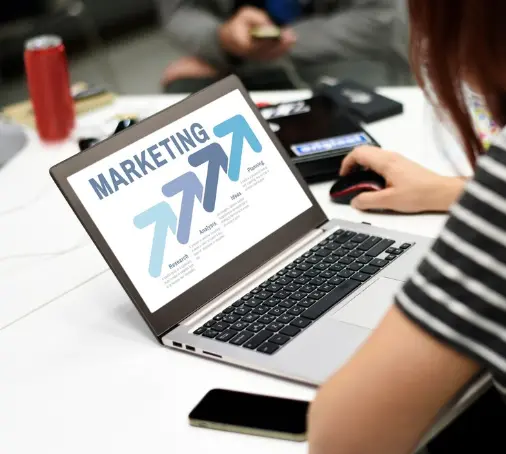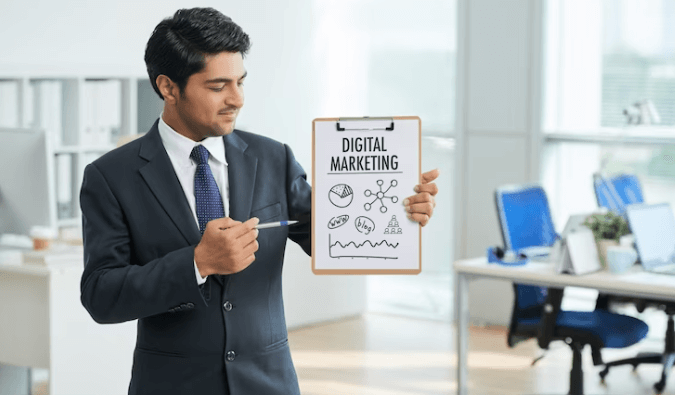AI is no longer a novel technology, particularly in advanced digital marketing. A 2022 global survey revealed that around 90% of marketers from 35 countries incorporate AI into their advanced digital marketing strategies. With a plethora of free and affordable tools, AI has become the top method for enhancing productivity and gaining deeper insights into audience behavior and engagement. Integrating AI into marketing workflows not only boosts efficiency but also improves the ability to understand and effectively target audiences.
Table of Contents
Trends: AI in advanced digital marketing
This article explores three exciting trends and best practices for implementing AI within your organization.
1. Generative AI
Thanks to ChatGPT, generative AI has become a major trend in marketing. Generative AI uses existing data and inputs to create new content. Some examples of generative AI tools include:
- Content creation tools that write blog posts, product descriptions, and other written materials.
- Software that generates images and videos for branding, explainer videos, social media posts, and blog graphics.
- Chatbots that interact with customers via SMS, email, or social media apps.
Currently, up to 75% of marketers use generative AI to enhance their content creation workflows or as a lead generation tool.
2. Personalization
AI enhances personalization in marketing by using real-time data to create tailored, data-driven experiences for each customer. Businesses can leverage AI across multiple channels to trigger personalized emails, social media messages, website popups, and offers based on a customer’s browsing history or past purchases. Additionally, AI enables marketers to analyze large volumes of customer behavior data, helping them develop better products, improve targeting and messaging for future campaigns, and adapt to evolving customer needs. This level of personalization and data analysis significantly improves customer engagement and satisfaction.
3. Voice Search Optimization
Voice search has become increasingly popular for consumers seeking quick information and making purchases via mobile devices. For businesses to remain relevant and accessible, optimizing content for voice search is essential. AI plays a pivotal role in this optimization by using natural language processing (NLP) to analyze speech patterns and understand the specific phrases used in voice queries. This analysis enables businesses to create content with a more conversational tone and structure, incorporating the keywords that voice assistants recognize easily. As a result, businesses can improve their visibility and effectiveness in voice search results.
Best Practices for Using AI in advanced digital marketing
How you integrate AI into your workflow can make the difference between producing exceptional marketing content that converts customers and mediocre content that repels them.
Key Points to Consider:
- Balance AI and Human Input:
While AI is cost-effective, don’t rely solely on it. AI lacks the human touch essential for effective communication with your target audience. Your unique selling proposition (USP), branding, and voice should come from human writers and designers.
- Automate with AI:
Use AI to handle routine tasks and save time. For instance, while ChatGPT may not excel at writing marketing content, it can significantly reduce research time by quickly gathering information from the web.
- Hire Industry Experts:
Outsource to professionals who understand both AI and your industry. For example, a marketing agency specialized in credit unions can better align AI technology with your specific goals and audience.
AI in advanced digital marketing is no longer a future speculation but a present necessity for any business aiming to excel in quality, targeting, and efficiency in 2024. Stay updated with the latest trends and best practices to effectively incorporate AI into your marketing workflow and achieve tangible results.
How AI could be about to reshape advanced digital marketing
AI technologies have evolved rapidly, transitioning from producing crude imitations of human content to becoming indispensable tools with transformative potential for the creative sector. Kate Farrell, head of design at the advanced digital marketing agency Sherbet Donkey, delves into the profound impact of AI on digital marketing practices.
Marketers perpetually seek innovative methods to achieve key performance indicators (KPIs) and streamline workflows. Recognizing AI’s dual potential in these areas, many are familiar with Large-Language-Models (LLMs) like ChatGPT and Copilot, which adeptly handle time-consuming tasks such as keyword research, copy drafting, and brainstorming.
While leveraging AI for routine tasks is common, the true excitement lies in the broader horizons it opens for advanced digital marketing. AI’s capacity to tackle challenges beyond human capability introduces groundbreaking opportunities, propelling the industry into uncharted territories of creativity and efficiency.
Deep Digger: Truth Of Digital Marketing Career And 12 Common Questions
AI & Data Analysis for Ads
Reviewing a few weeks’ worth of campaign data is straightforward and enables us to identify trends or issues warranting attention, fostering a sense of productivity and vigilance. However, when data is fed to AI, such as the social media algorithm curating your feed, it swiftly processes information, identifies patterns, and makes decisions in mere seconds. AI’s capacity to ingest vast datasets in the blink of an eye surpasses human capabilities by leaps and bounds. Picture a website that recalls your past purchases, offering suggestions for complementary items. By analyzing your browsing history and interactions, AI predicts your preferences, delivering personalized recommendations, whether it’s suggesting a new book series based on your favorite author or matching the perfect pair of headphones with your latest phone acquisition.
Laser-Focused Ad Targeting
No longer are screens cluttered with irrelevant ads of yesteryear. AI harnesses the ability to scrutinize demographics, online behavior, and even social media engagements, ensuring ads hit the mark with laser precision. Picture this: after browsing hiking trails online, you’re greeted with an ad showcasing the very boots you’ve been eyeing—this exemplifies the prowess of AI-driven ad targeting.
However, as users become increasingly cognizant of data privacy, these methods must evolve in tandem with their awareness.
Simultaneously, by automating mundane tasks, AI emerges as the ultimate time-saver. This liberates marketers to redirect their focus towards strategic initiatives: crafting comprehensive marketing strategies, mining data for trends and opportunities, nurturing customer relationships, and staying abreast of cutting-edge marketing trends.
Also Hit: Creative digital marketing Company
Customer Experience Enhancement
It’s crucial to remember that AI serves as a complement to human creativity and strategic thinking for a forward-looking marketing approach. While certain aspects of business necessitate a human touch, like customer experience (CX), AI tools offer expedited ways to engage customers with personalized messaging.
AI-powered chatbots, for instance, adeptly handle FAQs, troubleshoot basic issues, and guide customers to relevant resources. This not only boosts customer satisfaction but also liberates human customer service teams to address more complex inquiries. Additionally, AI facilitates sentiment analysis, deciphering customer feedback across various channels to gauge overall sentiment.
By delivering round-the-clock support and invaluable insights into customer sentiment, AI enables businesses to offer a more tailored and responsive CX. From personalized content and automated tasks to enhanced CX, AI presents a formidable upgrade for digital marketers. Leveraging AI strategically and ethically empowers businesses to craft targeted campaigns, glean valuable customer insights, and drive tangible results.
Demonstrating AI’s potential, the author input an outline of this article into ChatGPT, including desired topics and examples, and instructed it to structure the piece automatically with bullet point summaries of each paragraph. Subsequently, they fleshed out each paragraph accordingly.







